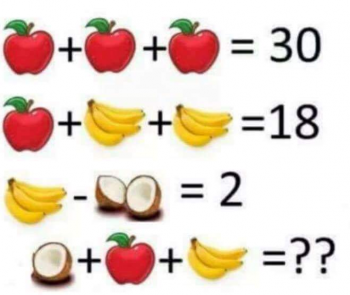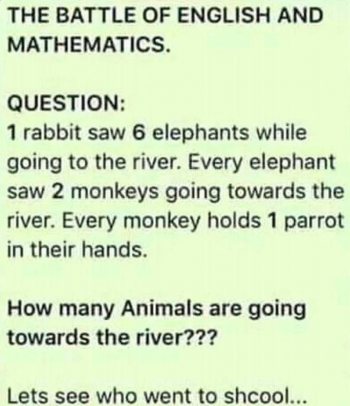Ask Professor Puzzler
Do you have a question you would like to ask Professor Puzzler? Click here to ask your question!
I'm Glad I've Got a Proofreader
In addition to occasionally writing math problems for this website, I've also written math problems for several states' math competitions. When I sit down to write problems, it's usually because I have to crank out a set of 100 math problems for a competition somewhere. When I'm finished writing them, I send them off to my proofreader. When he's proofreading, what do you suppose he's most likely to find?
- spelling mistakes
- grammar mistakes
- arithmetic errors
- algebraic errors
- ambiguity errors
He does occasionally find spelling/grammar mistakes, but those are fairly infrequent. And yes, I do occasionally have arithmetic/algebraic errors! (When I'm writing a problem, sometimes I have to try two of three different things to make the problem work out correctly, and then I forget which things I've changed, and use numbers from the first version of the problem, and then my proofreader says, "Where in the world does this number come from?")
But the most common issue he finds is an ambiguity issue. Ambiguity simply means that students could reasonably interpret the problem in more than one way. If the student could interpret the problem in multiple ways, then it's a bad problem!
Here's a simple example:
In a right triangle, the sides are 5, x, and x + 1. Find the length of the hypotenuse.
Why is this ambiguous? Because I've implied that there's one answer ("find the length" instead of "find all possible lengths") but there are two possible answers, because the hypotenuse could be 5 (if x and x + 1 are less than 5) or it could be x + 1 (if x + 1 is greater than 5).
Here's another example:
Find the next term in this sequence: 5, 10, 15, ...
The obvious answer is 20, but that's not the only possibility; someone who is familiar with Fibonacci sequences could argue that this is the beginning of a Fib, and therefore the next term is 10 + 15 = 25.
These are just simple examples. The more complicated a problem is, the more likely it is to introduce something ambiguous without meaning to. So I'm glad I've got a problem proofreader.
The Internet Has No Proofreader
Now I put on my other hat - the "Professor Puzzler" hat. On any given day, this blog is a pretty quiet corner of the internet. This blog usually gets just a few hundred visitors per day. (Except on days we publish a new post, then the visitor rate climbs a bit).
But every once in awhile, something goes crazy. Back in February, for instance, there was one day where the traffic to the Professor Puzzler blog was 100 times it's normal rate. We had over 25 thousand page views on just one page of the blog.
Whenever this happens, it's invariably because someone posted an ambiguous (bad) math problem on the internet, and someone linked to our explanation of why it can't be solved.
And I realized something, after the most recent one: the majority of math problems posted on social media are ambiguous. The internet has no proofreader.
If you're interested to see some of the ambiguous/bad problems we've talked about in this blog, here are links to some of them. Just click on the image to jump to the corresponding blog post.
The most recent one was "The Flower Problem" or (as one site called it) "Pollen Pandemonium." This problem is straight-up ambiguous (and no, it was not part of a kindergarten exam in China; give the Chinese some credit, will you?). The most appropriate interpretation is to say that each distinct flower image represents a different variable. If that's the case, you have a system of three equations in four unknowns, which is unsolvable. If you operate from the assumption that the problem must have a solution, you reject the most appropriate interpretation, and then there is no way to solve it without making an assumption about what the writer intended. Each assumption will lead you to an answer, but depending on the assumption you make, you'll get a different answer. So the internet is full of people arguing for their interpretation, when the reality is, every solution is based on an unwarranted assumption.
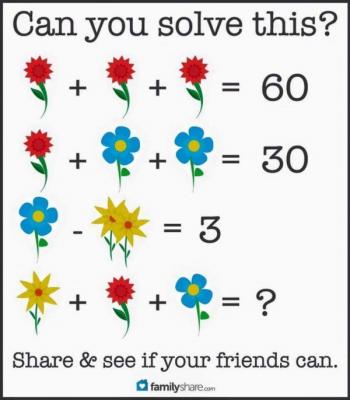
The square problem is also ambiguous in the same way that my sequence problem above is ambiguous; there are multiple ways of interpreting the intent of the problem writer, and there isn't one right answer; there are many possible answers. But the problem is great for click-bait sites, because people will spend all day arguing their answer in the comments.
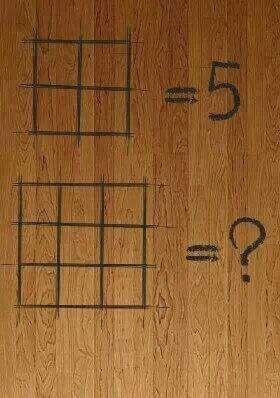
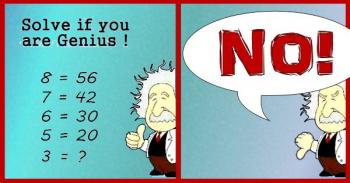
And there you have it: a history of bad math problems on the Ask Professor Puzzler blog. Click-bait sites love problems like this, because they generate arguments, and arguments turn into page views, comments, likes, and notoriety.
Math teachers, on the other hand, hate them...except as teaching tools about ambiguity!
Update June 20, 2016: One wise commenter responded to this blog post by saying "So people would rather argue, pretending unsolvable problems are solvable, than accept the simple fact that the problem was badly phrased to begin with. Seems this could have applications to Internet interactions far beyond the math realm!"
Can't argue with that!
"I noticed that all the perfect squares are either a multiple of 4, or they're one more than a multiple of 4. Is that a rule or something?" ~Wes in South Dakota
Wes, I don't know if it's a rule, exactly, but it's definitely a true statement. Every perfect square is either a multiple of four, or one more than a multiple of four. Would you like me to prove it?
Every integer is either even or odd. That means it's either a multiple of two, or it isn't. If it's a multiple of two, we can write it like this:
2n
If it's NOT a multiple of two, than it must be one more than a multiple of two. That means we can write it like this:
2n + 1
Every integer can be expressed either as 2n or as 2n + 1.
Therefore, every perfect square can be expressed as either (2n)2 or (2n + 1)2.
Now, if you've studied a bit of Algebra, you hopefully know how to simplify both of those expressions:
(2n)2 = 22n2 = 4n2
(2n + 1)2 = (2n + 1)(2n + 1) = 2n(2n + 1) + 1(2n + 1) = 4n2 + 2n + 2n + 1 = 4n2 + 4n + 1 = 4(n2 + n) + 1
Notice the result! The first possibility gives us a multiple of four, and the second one gives us one more than a multiple of four! And since that covers every perfect square, we can conclude that all perfect squares are either a multiple of four or one more than a multiple of four!
DailyMail.co.uk, and the various click-bait sites that copy their content, seem to be a bit confused on the difference between "hard" and "unsolvable." They recently discovered the "flower problem" (which everyone else was talking about four months ago), then they found our explanation of the problem, and posted a fine click-bait article headlined something along the lines of "Problem is so hard even a math teacher can't solve it."

There is a huge difference between something being "hard" and something being "unsolvable."
Let me give you an example:
John can mow lawns at a rate of 1 lawn every three hours. Jane can mow lawns at a rate of 2 lawns every five hours. If John and Jane work together, how many brick walls can they build in ten hours?
This is not a hard problem. It's actually very, very easy. It's very easy to recognize that the answer is "not enough information given." Information about rates mowing lawns doesn't tell us a blessed thing about their wall-building rates.
"Hard" implies that someone will actually spend a lot of time wrestling with the problem. But, in fact, you didn't spend any time at all on that, right? You knew immediately and instinctively that there wasn't enough information to solve it. That wasn't hard.
Here's another problem:
If x + y = 30, find the value of 2x - 3y.
Now this one is a little harder, because it might not be immediately apparent that there isn't enough information to solve the problem. Any first or second year Algebra student, however, shouldn't spend much time on that before they say, "Hey, wait a minute! There are two variables there, and only one linear equation, so I can't find x and y!"
Of course, a problem can be both hard and unsolvable. I used to get (on a regular basis) emails from people all over the world who were convinced that they had found a method of trisecting angles with a compass and straight edge. They spent hours and hours on their solutions - it was hard. And, sadly, despite all their hard work, they were wrong; the correct answer is, "It can't be done." And it has been proven. And the proof wasn't an easy one.
But...the flower problem is not hard.* It's very easy to see why the problem is not possible to solve. If you think you've found a numerical solution, make sure you think through exactly what assumptions you've made about the flowers and their petals (and their stems and leaves, because yes, you've probably made assumptions about those, too!), and then go read our blog post.
Thanks for visiting our site, and make sure you try out our educational games while you're here!
* Having said that the problem is not hard, I have to admit that it's excruciatingly painful to look at the comment sections on sites like DailyMail and realize that even setting aside the fact that you can't solve the problem without making assumptions, most people posting their "answers" don't even know elementary level mathematics and order of operations, and that there are almost as many answers given as there are comments made. So maybe the problem is harder than I thought.
And maybe DailyMail should have titled their article "So hard people think it can be solved." :D
For those who are interested in seeing more "bad math problems" on our blog, click the image below.
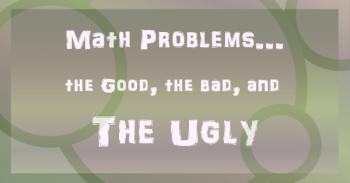
"Hi Professor, my algebra teacher multiplied 97 x 103 in her head, and said she "used algebra" to do it. Can you explain what she did? -Anon."
Sure, Anon. There are situations where knowing some algebraic factoring rules can be a big help in doing mental math, and the example your teacher gave is one of those situations.
In order to answer your question, you're going to need to know an algebraic factoring rule called the "difference of squares" rule. If you don't know it, here it is:
a2 - b2 = (a + b)(a - b)
It's easy to see why this is true, by using the distributive property on the right-hand side:
(a + b)(a - b) =
a(a - b) + b(a - b) =
a2 - ab + ab - b2 =
a2 - b2
So to solve 97 x 103 in your head, you need to recognize that 97 is three less than 100, and 103 is three more than 100, which means the following is true:
97 x 103 =
(100 - 3)(100 + 3) =
1002 - 32 =
10000 - 9 =
9991
All of that can be done mentally, without writing anything down on paper, and without using a calculator.
Is this a useful technique? Well, it's only useful if you're multiplying two things that are equidistant from something you know the square of.
I happen to know, for example that 162 is 256. So if someone asked me what 15 x 17 is, I would do this:
15 x 17 =
(16 - 1)(16 + 1) =
162 - 12 =
256 - 1 =
255
And since the only thing I actually did was subtract 1 from 256, I had the answer before you even started reaching for your calculator.
Speaking of 256...since I've done software work ever since I was in high school (back in the 1980s!), and have therefore worked extensively with powers of 2, I have this math fact indelibly imprinted on my brain:
2562 = 65,536
I will occasionally use this fact to freak out my math students. I'll write up on the board something like:
246 x 266 =
And then, while they're still punching that first number into their calculators, I'll finish writing the answer:
246 x 266 = 65,436
How did I do that in my head? Easy! I deliberately chose two numbers that are equidistant from 256:
246 x 266 =
(256 - 10)(256 + 10) =
2562 - 102 =
65,536 - 100 =
65,436
Of course, the "Difference of Squares" rule is not the only algebraic rule that could help us with mental math. Consider the following question:
Find the prime factorization of 1027.
To solve this mentally, you'll need the following rule for "Sum of Cubes"
a3 + b3 = (a + b)(a2 - ab + b2)
I note the following:
1027 =
103 + 33 =
(10 + 3)(102 - 10 x 3 + 32) =
13 x 79
Here's one more example:
Find the prime factorization of 1332.
1332 =
1331 + 1 =
113 + 13 =
(11 + 1)(112 - 11 x 1 + 12) =
12 x 111 =
(22 x 3) x (3 x 37) =
22 x 32 x 37
In practical, real world mathematics, these kinds of "stunts" don't usually gain you much, but they can be useful to math teachers in the classroom. If I'm working with students on prime factorizations, I might deliberately create a "sum of cubes" number so that I can find the factorization quickly in my head, and I'll therefore know if my students have the correct answer, without having to go through the work of doing a factor tree. (Yep, I'm lazy that way!)
"Your blog post about palindromic squaring made me wonder - how many palindromic perfect squares are there?" ~D.
As a quick review for anyone who missed the post you referred to, a palindrome is a number (or word) that is the same forward and backward. For example 121 is a palindrome, because if you write it backwards, it's still 121.
So how many perfect squares are there that are palindromes? 121 is one example, but surely there must be others?
Yes. In fact, there are infinitely many perfect squares that are palindromes. Would you like a proof?
Let x = 10n + 1.
Then x2 = (10n + 1)(10n + 1)
x2 = 10n(10n + 1) + 1(10n + 1)
x2 = 102n + 10n + 10n + 1
x2 = 102n + 2·10n + 1
Written in base ten notation, this number would have 2n + 1 digits. The (n + 1)th digit would be 2, the first and last digits would be ones, and all the other digits would be zeroes. Since n+1 is halfway between 1 and 2n + 1 (note that n + 1 is the average of 1 and 2n + 1), the digits "mirror" each other, and the number is palindromic. This works for every positive integer n, which means there are an infinite number of palindromic perfect squares. Just so you can see an example of this, let n = 4. Then we have:
x = 104 + 1 = 10001.
100012 = 100020001, which is a palindrome.
Of course, these all take the same form; a one at the beginning and end, a two in the middle, and everything else zero. You can find ones that take different forms:
2122 = 44944
1011012 = 10221412201
1111000011112 = 12343210246864201234321
And I submit (without proof) that for every form you find, you can create infinitely many palindromic perfect squares by inserting zeroes between the digits of the number you square.
